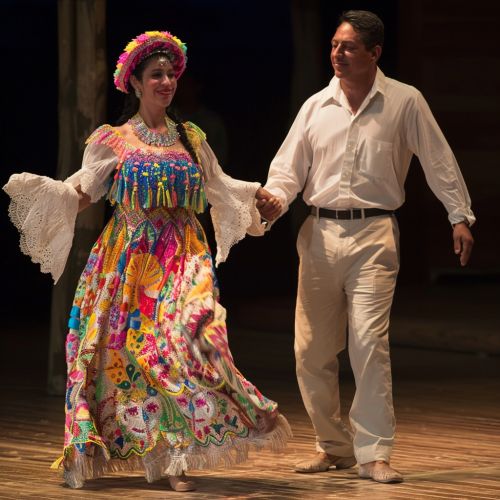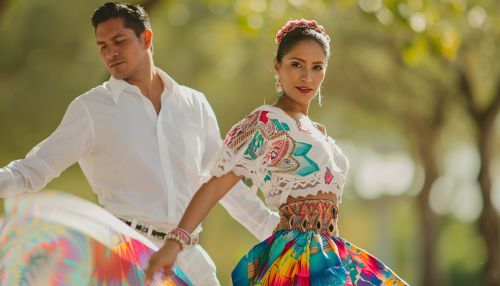Tamborito: Difference between revisions
No edit summary |
No edit summary |
||
| Line 17: | Line 17: | ||
The costumes worn during Tamborito performances are also significant. Women typically wear polleras, which are elaborate, colorful skirts adorned with lace and embroidery. Men wear traditional white shirts and trousers, often accompanied by a hat known as a sombrero pintao. | The costumes worn during Tamborito performances are also significant. Women typically wear polleras, which are elaborate, colorful skirts adorned with lace and embroidery. Men wear traditional white shirts and trousers, often accompanied by a hat known as a sombrero pintao. | ||
[[Image:Detail-79197.jpg|thumb|center|A couple performing the Tamborito dance in traditional Panamanian attire. The woman is wearing a colorful pollera, and the man is dressed in a white shirt and trousers.]] | [[Image:Detail-79197.jpg|thumb|center|A couple performing the Tamborito dance in traditional Panamanian attire. The woman is wearing a colorful pollera, and the man is dressed in a white shirt and trousers.|class=only_on_mobile]] | ||
[[Image:Detail-79198.jpg|thumb|center|A couple performing the Tamborito dance in traditional Panamanian attire. The woman is wearing a colorful pollera, and the man is dressed in a white shirt and trousers.|class=only_on_desktop]] | |||
== Cultural Significance == | == Cultural Significance == | ||
Latest revision as of 13:01, 17 May 2024
History and Origins
Tamborito is a traditional Panamanian folk dance and music genre that has deep roots in the cultural history of Panama. It is considered one of the most emblematic expressions of Panamanian folklore. The origins of Tamborito can be traced back to the colonial period, where it evolved from a blend of Spanish, African, and Indigenous influences. The name "Tamborito" translates to "little drum," which is indicative of the central role that percussion instruments play in this musical genre.
The dance and music of Tamborito were initially performed during social gatherings and community celebrations. Over time, it became an integral part of Panamanian national identity, often performed during festivals, national holidays, and other significant events. The African influence is particularly notable in the rhythm and use of drums, while the Spanish influence is evident in the lyrical content and melodic structure.
Musical Structure
Tamborito music is characterized by its distinctive rhythm, which is created using a variety of percussion instruments, including the caja (a small drum), the repicador (a higher-pitched drum), and the pujador (a bass drum). These instruments work together to create a complex, interlocking rhythm that serves as the foundation for the music.
The vocal component of Tamborito typically involves a call-and-response pattern, where a lead singer (cantador) sings a verse, and a chorus of singers responds. The lyrics often tell stories or convey messages related to love, nature, and daily life. The melodic lines are usually simple and repetitive, which allows for improvisation and variation during performances.
Dance Elements
The dance associated with Tamborito is equally important and is performed by couples who move in a circular pattern. The dance is highly rhythmic and involves intricate footwork, hip movements, and hand gestures. The male dancer typically leads, while the female dancer follows, often mirroring his movements. The dance is both a social and a performative activity, with an emphasis on coordination and timing.
The costumes worn during Tamborito performances are also significant. Women typically wear polleras, which are elaborate, colorful skirts adorned with lace and embroidery. Men wear traditional white shirts and trousers, often accompanied by a hat known as a sombrero pintao.


Cultural Significance
Tamborito holds a special place in Panamanian culture and is often seen as a symbol of national pride. It is performed during major cultural events such as the Carnival of Panama, the Festival de la Mejorana in Guararé, and various other regional festivals. The dance and music serve as a means of preserving and transmitting cultural heritage from one generation to the next.
In addition to its role in celebrations, Tamborito has also been a subject of academic study. Ethnomusicologists and cultural historians have examined its origins, evolution, and significance within the broader context of Latin American folk traditions. The genre has been recognized by UNESCO as an intangible cultural heritage, further highlighting its importance.
Variations and Regional Differences
While Tamborito is a national symbol, there are regional variations that reflect the diverse cultural landscape of Panama. For example, the Tamborito of the Azuero Peninsula is known for its faster tempo and more elaborate dance movements, while the version from the province of Colón incorporates elements of Afro-Caribbean music and dance.
These regional differences are often celebrated during local festivals, where communities showcase their unique interpretations of Tamborito. This regional diversity adds to the richness and complexity of the genre, making it a dynamic and evolving form of cultural expression.
Modern Adaptations and Influence
In recent years, Tamborito has been adapted and incorporated into various modern musical genres, including salsa, reggaeton, and Latin pop. Contemporary Panamanian artists often blend traditional Tamborito rhythms with modern instrumentation and production techniques, creating a fusion that appeals to younger audiences while preserving the essence of the original genre.
Educational institutions and cultural organizations in Panama also play a crucial role in keeping Tamborito alive. Schools often include Tamborito in their music and dance curricula, and cultural centers offer workshops and performances to educate the public about this important aspect of Panamanian heritage.
